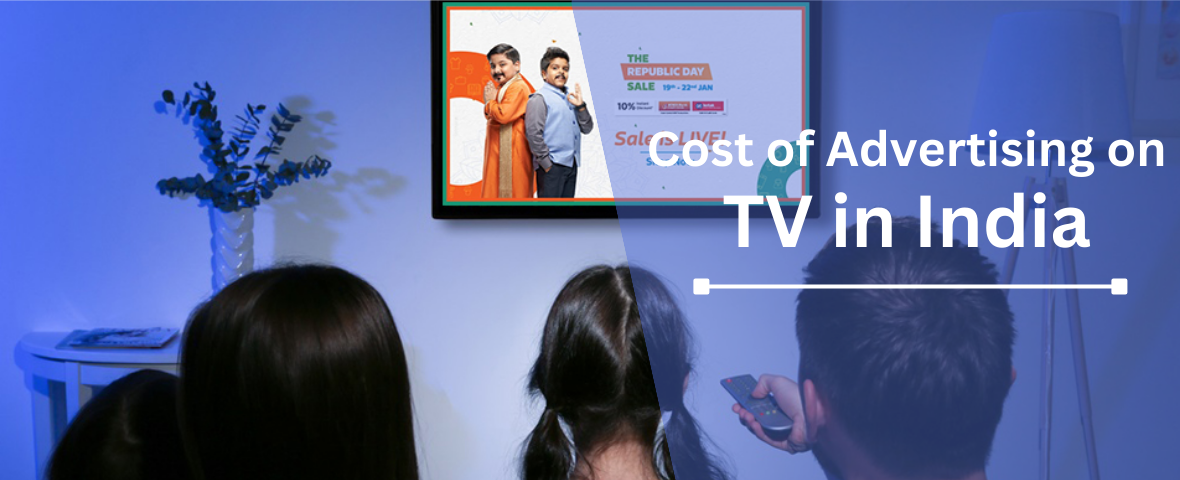
Cost of Advertising on TV in India
Going back in history, in the year 1941, television advertisement was first seen in America. Its impact was so strong that within a decade it spread all over the European countries, Canada, Australia and Japan. In India, though it was first commissioned in 1949 as an experiment, it was not until 1976 that TV commercials started. The perfect synchronization of sounds, light, motion, colour and immediacy is what is known as television telecasting. Earlier transmitting stations in India were known as Doordarshan Kendras, transmission in colour started in 1982 and with that came the advent of TV advertising in India.
A television advertisement is typically a span of television programming produced and paid for by a brand. Advertising on television allows marketers to reach out to a wide array of audiences about different products or services. It allows marketers to show the benefits of ownership. Ever since television came into being, TV advertising has been a popular medium for large retailers. Moreover, with the arrival of cable television, the production costs became lower and the chance to reach a smaller, more targeted market, became possible. This is what makes TV advertising a viable option for any size business.
Television advertising essentially involves three main tasks: –
First is creating a television advertisement that is at par with broadcast standards.
Second is making sure that the advertisement on television is placed in a way that it reaches the desired target market.
The third is measuring the results of these ads.
As mentioned before, the first television advertisement came out in the United States on July 1 in the year 1941 while in the United Kingdom, it came out on September 22, 1955. The first television advertisement in Asia is known to have appeared on Nippon Television in Tokyo back in 1953, on August 28. The first television advertising that appeared in India was on January 1, 1976, for Gwalior Suitings.
The Indian television channels are broadly segregated. These are Broadcast television, Cable television, Satellite television, and Internet Protocol Television. In India, televisions are broadcasted in homes through cables and direct-to-home (DTH). The Television advertising rates vary for TV ad spots, regional, and national channels, prime time, non-prime time and on media planning platforms. Television ads leave a long-lasting impact on the minds and it helps to enable brand credibility.
Television advertising provides a humungous reach that no other media platform could compete with. Till today, watching television continues to be one of the popular media. TV advertising provides great business profit and helps drive market share. Additionally, marketers must not forget that a major factor is that people across the globe trust TV advertising, thus providing a large-scale reach to advertisers.
Key Factors Affecting the Cost of TV Advertising
While planning a campaign, among all other factors, managing the cost is something that needs thorough planning. Technically speaking, the rates of TV advertising depend on the suitability of the audience to the potential advertiser. Also, factors like viewers’ demographics, time, channel and the location in which ads are aired play a pivotal role in deciding the rate of advertising. Now let’s discuss some of the key factors affecting the cost of TV advertising in India:
Channel of the TV Show or the Channel Itself: Advertising spots on popular TV channels and TV shows will charge more.
Demographics of Viewers: It is a fact that advertisers want their ads to reach an audience who can spend money. The preferred age group of the advertisers is usually between 25 to 55 years. This is because people within this demographic are employed and have buying power.
Live Viewership: Programs that need to go live always cost more. In other words, it will cost more to place an advertisement during sports matches, singing, dance or cooking competitions than the usual TV shows.
Time Selection: Primetime is an essential term in Indian media. The rates of getting the spots for an ad spot are usually higher than other slots. In India, prime time is the time around 7 pm to 11 pm in regards to Television. Audience engagement is at its highest during this time slot and hence it is considered to be the best time to advertise.
Geographical Location: TV commercial pricing also depends on geographical location. On average, people living in metropolitan cities have spending power as compared to people living in other areas or cities. Automatically, being the hotspot, advertisers have to spend more for placing their advertisements in big cities.
Length of the advertisement: The length of the TV advertisement will greatly impact the TV commercial expenses. The cost for a short ad will cost a lesser than those with longer time slots.
Also read: Delhi Metro Advertising Cost
Types of Television Advertising
Broadly speaking, there are two types of television advertising. They are:
Sponsored Programmes: Films, series or daily soaps that are sponsored by the advertisers are sponsored programmes. Advertisers can benefit by advertising during these shows. Sponsored programmes can be of great benefit:
It has the capability to build a seamless image of the advertising house and its product. These programmes are best for brands that are aiming to create a place in the market. These programmes help in brand recall, in some cases, the programmes are often synonymised by the brand.
It gives liberty to the advertisers to design the programme content as per the need of their product or service.
Announcements or the usual TV Ads
The kind of advertisement that is presented to the audience during the programme is generally considered an announcement. It is the familiar type of ad that everyone knows about. In this type, advertisers pay only for the duration of the advertisement and its frequency. A group of advertisers go for this type of TV commercial because
These ads are very handy in terms of money. Advertisers can save money. Even small business owners can opt for this type of advertising.
When thinking of TV advertising, one must weigh its pros and cons. The advantages of TV advertising include the possibility to maximise sales with greater audience engagement, the ability to pair visuals and sound and narrate stories and stirring emotions. Overall, it provides an opportunity to reach a nationwide large audience, whereas disadvantages may include, the need to entertain the audience and hook them up to watch the ad, the tendency for people to switch their attention during commercials, and also difficulty in tracking the success of the advertisement.
TV Advertising Advantages include:
- Covering a very large and wide audience
- Giving an opportunity to advertise nationwide
- Keeping the audience engaged with great storytelling that is not generally possible in print or text
- Ideal for brands or services that want to stay at the top of trends and in the minds of people
Disadvantages of TV Advertising include:
- Even though people are tuned in, they might not be paying attention to the commercial
- Tracking and measuring performance becomes difficult. Also, checking the success of the ad campaign takes time, as the results come in real time.
- Involves a large investment, which makes it a challenging marketing strategy, especially for beginners.
Ad Options on Television: Advertisements on television are played both throughout the break or during the content being played. Some famous advertising options available for TV that marketers must be aware of are:
- Video Ads: Video ads are generally broadcasted during the ad breaks and the least duration for a particular video ad is 10 seconds and can be increased to 15 seconds.
- L Bands: Aston Bands are thin horizontal strips that appear during programs at the end of the TV screen. Technically, the duration of Aston Band per exposure is 10 seconds. Marketers can choose the number of Aston Bands per day and the total number of days they would prefer to advertise. Prices are set according to the time band chosen.
- Brand Integrations: Some programs are brand-sponsored. In this type, the program integrates the brand name or products or services offered by the brand while being on air.
Now let’s talk about the cost of an Advertisement on TV in detail.
Television Advertisement Pricing completely depends on factors like creative length, selected time band, location and duration of the campaign. The rates are charged on the basis of per second of airtime. For example, if the cost of TV advertising is mentioned as Rs 700/sec and an ad is 15 sec long, then the cost of playing the ad once will come to Rs 700 X 15which is Rs 10,500. Also, the rates for prime time as mentioned earlier, are comparatively higher than the non-prime time.
Brands in India largely rely on the art of storytelling to capture the audience’s emotions.TV ads due to their high cost and rigorous standards are often self-selective in nature. This also helps to build a healthy credibility and premium perception for brands that choose to advertise on TV. Television advertising also helps to build a premium brand perception not only amongst the consumers but also the trade partners. TV commercials have often traditionally catered to the needs of the manufacturers in India. Broadcasters in an Indian Television channel can help marketers and brands reach out to a target group on the national level. It is also possible for brands to enter an even more local audience through the channels broadcasting
Also read: Cost of Billboard Advertising in India



